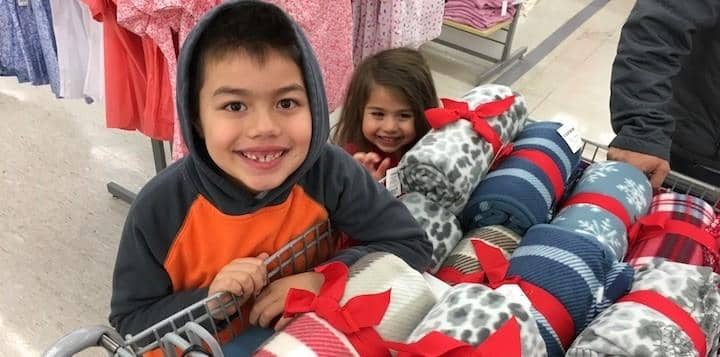My girls and I were walking to a park recently when we passed a tent set up on the sidewalk. “Mommy, is that person a refugee?” asked Edie, 4. We had been talking a lot about people who are forced to leave their homes and go someplace safer, so her guess wasn’t completely out of the blue.

“No, honey,” I started, though the real answer is somewhat more complicated: After all, many of our country’s houseless citizens are like refugees, displaced because of domestic violence or economic injustice. “The person who lives in this tent is homeless. They don’t have another place to go, so they sleep here.”
The encampment we passed was far from unique in our community. Last year, more than 13,000 Oregonians didn’t have a stable, safe place to sleep every night and so ended up staying in a shelter, in a vehicle, on the street or at a friend or relative’s house. And nearly 60 percent of homeless families slept in a car or on the street — the highest rate in the nation in 2016, according to the U.S. Department of Housing and Development. Increases in homelessness mirror the increase in housing costs: Rent in Portland rose 20 times faster than median household income over the last two years.
The numbers are staggering, and chances are, you and I know an adult, child or family who has lived through homelessness, said Brandi Tuck, executive director of the nonprofit Portland Homeless Family Solutions (PHFS). “It’s not fair that someone can work full time, but still not make enough money to afford rent,” she says. “But we can do something to help. That’s the message to give to young children.”
How to talk about homelessness
When my girls became old enough to begin asking questions about the world around them, I promised myself I would always do my best to answer honestly — within age-appropriate boundaries, of course. Shushing their curiosity or pretending a problem doesn’t exist only reinforces stigma against vulnerable groups, like those living on the street.
Still, I sometimes struggle with how to explain a complicated issue like homelessness, which is tied into skyrocketing housing costs, domestic abuse, mental illness, substance abuse, systemic racism and a whole host of other thorny topics.
So I explain in terms even my 2-year-old can understand. “Sometimes people have nowhere else to go. It might not be safe where they used to live, or they don’t have enough money to buy a house,” I say.
Then I ask questions: Would it be warm or cold to live in a tent on the sidewalk in winter? How would it feel to not have a place to sleep? These questions encourage empathy, and they show that someone living on the street is just like them: A person who might feel hungry, cold or afraid.
How families can help the homeless
I always follow up a tough conversation like that with an opportunity to show my kids that even though they are little, they can make a difference. Here are some ideas for you and your children to help our neighbors who experience homelessness.
Collect supplies.
The girls and I make a special date at least once a year to buy the most-needed supplies for someone living on the street. It’s not a huge investment — I spend about $25 at the Dollar Store for one person, plus about $10 monthly to keep a stock of basics baggies (peanut butter pouch, socks, travel pack of Kleenex, hand warmers) in my car. While the girls help me select shaving cream, hats, snacks and other in-demand goods, we talk about how each item will help someone. One time Edie asked me, “Can we buy a tent?” If ever I had any doubt that our efforts to teach her and Maxine, 2, how to care about the world, that one question proved they’re helping these two grow into compassionate givers.
Hold a drive.
My friend Kristin’s two kids, then 6 and 3, started the Share the Warmth Club last year when Portland was snowed in. Her son Lucas initially wanted to give away his bed to people sleeping out in the cold, but he and his younger sister collected coats and blankets from neighbors instead. They ended up delivering nearly 100 pounds of cold weather gear to the Portland Rescue Mission.
Make a care package.
Edie and I have made care packages for a child living in an emergency shelter through Little Loving Hands, a monthly subscription service that mails kids projects to help them do good. Edie made a hand-tied pillow, a memory game and a card, which gave my craft-loving preschooler a concrete way to help “children with no houses,” as she says. (Find them at littlelovinghands.com.)
Cook — and share — dinner.
Another way we can chip in together is cook dinner for Portland Homeless Families Solutions, which has shelters in Northwest and Southwest Portland. Every night of the year, volunteers cook, serve and sit down to eat with the emergency shelter residents — even with young children. The in-person interaction is a great way to counteract myths about the homeless, Tuck adds: “A child who is homeless is just another kid who doesn’t want to eat his broccoli!”
Raid the hotel.
My family teases me because I live by the no-shampoo-left-behind rule: I bring home all the travel-sized toiletries from hotels and, once I have a bag full, donate them to a food pantry, program for foster children or emergency shelter. Tuck suggests I let Maxine and Edie collect them instead, then bring them directly to the office of a nonprofit serving the homeless so the girls can better understand the impact of their gift. “It’s just one simple way kids can learn to give to those who need help,” she says.
